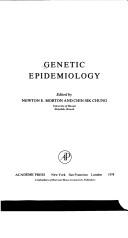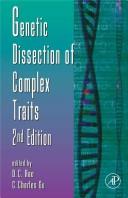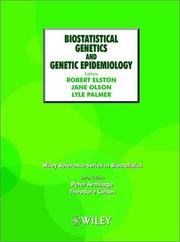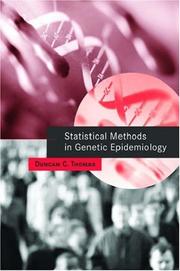| Listing 1 - 10 of 30 | << page >> |
Sort by
|

ISBN: 9781861348975 9781861348982 Year: 2011 Publisher: Bristol Policy Press
Abstract | Keywords | Export | Availability | Bookmark
 Loading...
Loading...Choose an application
- Reference Manager
- EndNote
- RefWorks (Direct export to RefWorks)
Book
ISBN: 9789175199900 Year: 2012 Publisher: Linkopings Universitet
Abstract | Keywords | Export | Availability | Bookmark
 Loading...
Loading...Choose an application
- Reference Manager
- EndNote
- RefWorks (Direct export to RefWorks)
This book is a comprehensive epidemiological study on multiple sclerosis (MS) in Sweden, with a particular focus on the county of Värmland. It examines the prevalence, incidence, and mortality rates of MS, exploring both environmental and genetic risk factors. The study analyzes data from hospitals and health care units, as well as historical industry data, to investigate correlations with MS prevalence and mortality. The book also discusses the sex ratio of MS in Sweden and the potential causes of the disease. It aims to provide insights into the distribution and determinants of MS to aid in prevention and treatment efforts.
Book
ISBN: 1139167987 Year: 1993 Publisher: Cambridge : Cambridge University Press,
Abstract | Keywords | Export | Availability | Bookmark
 Loading...
Loading...Choose an application
- Reference Manager
- EndNote
- RefWorks (Direct export to RefWorks)
Recent developments in molecular and computational methods have made it possible to identify the genetic basis of any biological trait, and have led to spectacular advances in the study of human disease. This book provides an overview of the concepts and methods needed to understand the genetic basis of biological traits, including disease, in humans. Using examples of qualitative and quantitative phenotypes, Professor Weiss shows how genetic variation may be quantified, and how relationships between genotype and phenotype may be inferred. This book will appeal to many biologists and biological anthropologists interested in the genetic basis of biological traits, as well as to epidemiologists, biomedical scientists, human geneticists and molecular biologists.
Medical genetics. --- Human genetics. --- Genetic epidemiology.
Book
ISBN: 1107172802 128090982X 9786610909827 0511286635 0511285914 0511284330 0511322100 0511618891 0511285159 Year: 2007 Publisher: Cambridge : Cambridge University Press,
Abstract | Keywords | Export | Availability | Bookmark
 Loading...
Loading...Choose an application
- Reference Manager
- EndNote
- RefWorks (Direct export to RefWorks)
Genetics, Health Care and Public Policy is an introduction to the new discipline of public health genetics. It brings together the insights of genetic and molecular science as a means of protecting and improving the health of the population. Its scope is wide and requires an understanding of genetics, epidemiology, public health and the principles of ethics, law and the social sciences. This book sets out the basic principles of public health genetics for a wide audience from those providing health care to those involved in establishing policy. The emphasis throughout the text is on providing an accessible introduction to the field. The content moves from the basic concepts, including definitions and history, through chapters on genetics, genetic technology, epidemiology, genetics in medicine, genetics in health services, ethical, legal and social implications, to the implications for health policy. It provides one-stop, introductory coverage of this rapidly developing and multidisciplinary field.
Human genetics. --- Genetic epidemiology. --- Public health.

ISBN: 0125080506 Year: 1978 Publisher: New York (N.Y.) : Academic press,
Abstract | Keywords | Export | Availability | Bookmark
 Loading...
Loading...Choose an application
- Reference Manager
- EndNote
- RefWorks (Direct export to RefWorks)
Genetic epidemiology --- Human genetics --- Medical genetics --- Congresses. --- Congresses. --- Congresses.
Book
ISBN: 0309307074 0309307058 Year: 2014 Publisher: Washington, District of Columbia : National Academies Press,
Abstract | Keywords | Export | Availability | Bookmark
 Loading...
Loading...Choose an application
- Reference Manager
- EndNote
- RefWorks (Direct export to RefWorks)
"Population surveys traditionally collect information from respondents about their circumstances, behaviors, attitudes, and other characteristics. In recent years, many surveys have been collecting not only questionnaire answers, but also biologic specimens such as blood samples, saliva, and buccal swabs, from which a respondent's DNA can be ascertained along with other biomarkers (e.g., the level of a certain protein in the blood). The National Health and Nutrition Examination Survey (NHANES), sponsored by the National Center for Health Statistics (NCHS), has been collecting and storing genetic specimens since 1991, and other surveys, such as the Health and Retirement Study (HRS) funded by the National Institute on Aging, have followed suit. In order to give their informed consent to participate in a survey, respondents need to know the disposition and use of their data. Will their data be used for one research project and then destroyed, or will they be archived for secondary use? Sponsors of repeated cross-sectional surveys, such as NHANES, and of longitudinal surveys that follow panels of individuals over time, such as HRS, generally want to retain data for a wide range of secondary uses, many of which are not explicitly foreseen at the time of data collection. They typically inform respondents that their data will be stored in a secure manner and may be provided to researchers with suitable protections against individual identification. The addition of biologic specimens to a survey adds complications for storing, protecting, and providing access to such data and measurements made from them. There are also questions of whether, when, and for which biologic measurements the results should be reported back to individual respondents. Recently, the cost of full genomic sequencing has plummeted, and research findings are beginning to accumulate that bear up under replication and that potentially have clinical implications for a respondent. For example, knowing that one possesses a certain gene or gene sequence might suggest that one should seek a certain kind of treatment or genetic counseling or inform one's blood relatives. Biomedical research studies, in which participants are asked to donate tissues for genetic studies and are usually told that they will not be contacted with any results, are increasingly confronting the issue of when and which DNA results to return to participants. Issues in Returning Individual Results from Genome Research Using Population-Based Banked Specimens, with a Focus on the National Health and Nutrition Examination Survey is the summary of a workshop convened in February 2013 by the Committee on National Statistics in the Division of Behavioral and Social Sciences and Education of the National Research Council. This report considers how population surveys, in particular NHANES, should implement the reporting of results from genomic research using stored specimens and address informed consent for future data collection as well as for the use of banked specimens covered by prior informed consent agreements. The report will be of interest to survey organizations that include or contemplate including the collection of biologic specimens in population surveys for storing for genetic research. The issues involved are important for advancing social, behavioral, and biomedical knowledge while appropriately respecting and protecting individual survey respondents."--
Genomics --- Genetic epidemiology --- Genetics --- Research. --- Moral and ethical aspects.
Book
ISBN: 0195062876 9780195062878 Year: 1990 Publisher: New York Oxford Oxford University Press
Abstract | Keywords | Export | Availability | Bookmark
 Loading...
Loading...Choose an application
- Reference Manager
- EndNote
- RefWorks (Direct export to RefWorks)
Human population genetics --- Demography --- Genetic epidemiology --- Genetics, Population --- Congresses. --- congresses. --- Congresses --- Human population genetics - Congresses --- Demography - Congresses. --- Genetic epidemiology - Congresses. --- Genetics, Population - congresses

ISBN: 9780123738837 0123738830 Year: 2008 Publisher: London ; Burlington, MA :,
Abstract | Keywords | Export | Availability | Bookmark
 Loading...
Loading...Choose an application
- Reference Manager
- EndNote
- RefWorks (Direct export to RefWorks)
Epidemiology. --- Epidemiology. --- Epidemiology. --- Genetic epidemiology. --- Genetic epidemiology. --- Genetics, Medical. --- Genetics. --- Génétique médicale. --- Medical genetics. --- Medical genetics. --- Syndromes --- Syndromes --- Épidémiologie génétique. --- Épidémiologie. --- Aspect génétique. --- Genetic aspects.

ISBN: 0471486310 Year: 2002 Publisher: London Wiley
Abstract | Keywords | Export | Availability | Bookmark
 Loading...
Loading...Choose an application
- Reference Manager
- EndNote
- RefWorks (Direct export to RefWorks)
Biomathematics. Biometry. Biostatistics --- Mathematical statistics --- Genetics --- Human genetics. --- Genetic epidemiology. --- Génétique humaine --- Génétique humaine

ISBN: 1280845309 0199748055 1429420642 9780199748051 9781280845307 9781429420648 9786610845309 6610845301 9780195159394 019515939X 019773796X Year: 2004 Publisher: Oxford New York Oxford University Press
Abstract | Keywords | Export | Availability | Bookmark
 Loading...
Loading...Choose an application
- Reference Manager
- EndNote
- RefWorks (Direct export to RefWorks)
This text has a focus on methods of identifying the joint effects of genes and environment on disease patterns. It follows the natural sequence of research, taking readers through study designs and statistical analysis techniques and offering examples from the literature on genetic epidemiology.
Genetic epidemiology --- Molecular epidemiology --- Statistical methods. --- Molecular epidemiology. --- Epidemiology --- Molecular aspects
| Listing 1 - 10 of 30 | << page >> |
Sort by
|

 Search
Search Feedback
Feedback About UniCat
About UniCat  Help
Help News
News